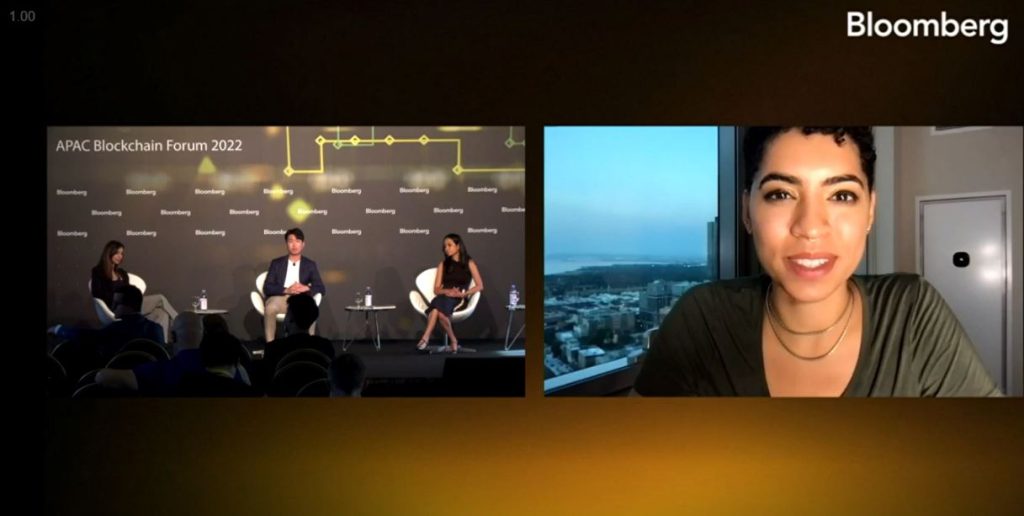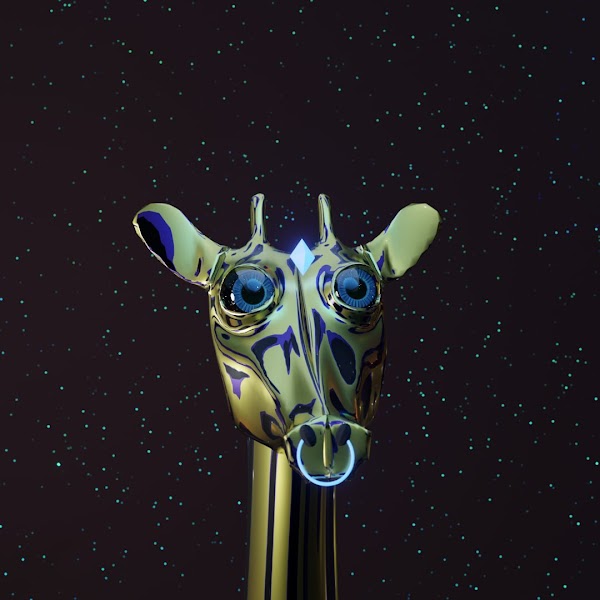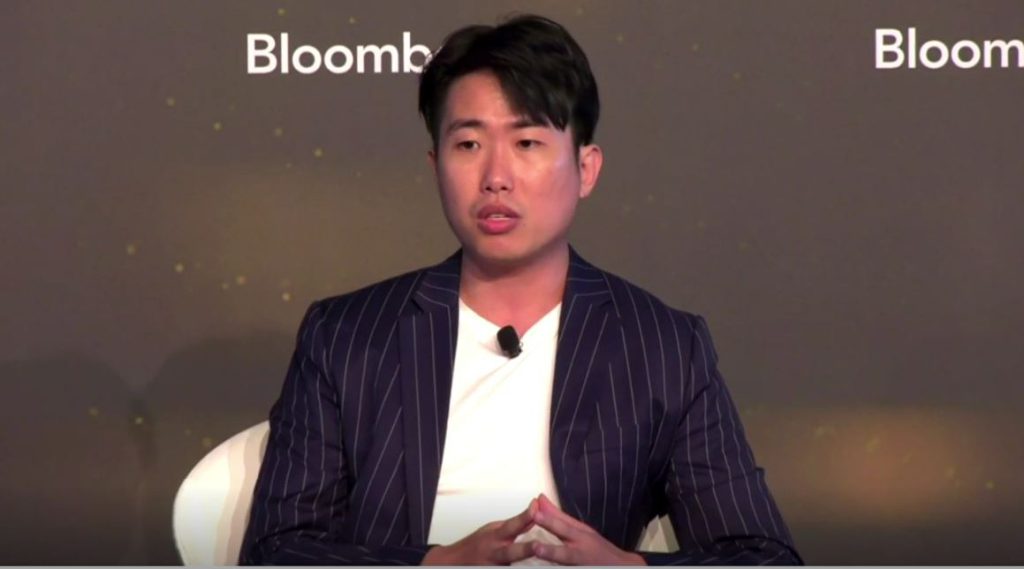Bloomberg’s APAC Blockchain Forum 2022 was recently held from 30th June to 1st July. Various speakers and veterans were invited to the Web 3.0 space amidst the volatile and brutal bear market of 2022 to talk about NFTs and the Metaverse.
The NFT Metaverse panel was moderated by Nezza Tilani, Account Manager from Bloomberg LP and featured the following speakers:
Natasha Damodaran, Managing Director of Vogue Singapore, Carney Mak, Head of Investments at FXHB Asset Management, and Sunny Satva, Founder and Director of Vegan Africa Fund (VAF).

The three shared their thoughts, experiences, and predictions on NFTs and the Metaverse.
Are NFTs just “Right Click, Save”?
NFTs represent the evolution of how we view and own digital assets. Given that we spend so much time in the digital world, it is no surprise that there is value in owning and authenticating our digital identity.
While many may have opposing views on it, there is a lot of industry interest in the world of NFTs.
Big names like Cristiano Ronaldo are already into NFTs. Fashion brands like Gucci and banks like HSBC are also interested in the Metaverse as well.
Proud to be partnering with @binance
— Cristiano Ronaldo (@Cristiano) June 23, 2022
Together we’ll give you the opportunity to own an iconic piece of sports history.
I’m excited to take this journey with all of you. Let’s change the NFT game with #Binance. pic.twitter.com/SNSCMHggct
As an industry worth billions, is it just “right-click, save as”? For Vogue Singapore, they see that this idea of ownership can have great use-cases for luxury brands and products.
The community aspect of NFTs is also essential as well. It is a good starting point for people to build their movement and find people with aligned interests.
For example, someone owning a similar NFT in the same collection as you. You will probably feel that there is something in common between you and the other party.
This is something that the (VAF) has also recognized, leading to the launch of their own NFT collections.
Entering the space
Media leads the way. Vogue Singapore was one of the first to step into the Metaverse, launching an NFT collection titled “New Beginnings”.
Affected by the lockdowns in September last year, it was difficult for Vogue Singapore to find a concept of new beginnings and change that could resonate with the audience.
By looking into the Metaverse and the creative Renaissance, they found a solution to their troubles.
By working with artists like Chad Knight and the Fabricant, they came up with a brand new concept for their magazine covers – relying on QR codes and launching a curated NFT collection on OpenSea for their digital print.

Print media has been disrupted by both the Internetthe Internet and online news birth social media came to dominate the space.
A disruptive platform with newer tech-savvy audiences was something Vogue Singapore was already familiar with, and Web 3.0 happened to be the right candidate for a new shift.
The transition of a fashion brand stepping into the NFT world did not stop there.
In May, Vogue Singapore also partnered with digital artists from The MetaArt Club (TMAC), such as Keiken, SuzyQ, Wu Ziyang, CryptoZR (Liu Jiaying) and Owo Anietie to launch an NFT collection, titled ‘Every Body’.

However, some of us may be curious: is there a use case in buying and owning NFTs?
NFTs and utility
For Sunny, utility in NFTs is something that the VAF emphasizes. The excellent utility can positively impact all parties.
NFTs from the VAF act as a form of investmanhe funds go into environmentally-conscious companies under VAF that create sustainable products.
Essentially, one NFT entitles the holder to a gift basket of various goods and products that are produce dentures backed by VAF.
One such collection was Astral Giraffes, launched on the low-carbon-emission Harmony Protocol.

This collection seeks to raise awareness for conservation efforts and provide funds for the companies VAF has invested in.
This is a form of utility. The NFT helps fund companies to create sustainable green products and expand the network while giving back some value to the user in the gift basket – a “green chip” NFT.
For Vogue Singapore, a collection was also launched in order to raisetoUkrainian war efforts. Titled “Fashion For Peace”, this highly curated art collection was a breath of fresh air, compared to thegenerative art and profile pictures that had taken the NFT crypto world by storm last year.

The ease of raisiAs compared to traditional banking, the funds in Web 3.0 via NFTs, as compared to e aspect for both organizations.
But what about NFTs as an investment?
The NFT bubble
Carney Mak thinks that NFTs are in a bubble. However, this is no ordinary bubble – crypto is decentralized and has lowered barriers of entry. Anybody can participate and form a movement.

Due to what is happening in the markets now, it is likely thatregulation and perhaps even taxation for NFT trading might likely, at the end of the day, there is something of value to be found in the space.
The younger generation is more focused on owning things and is savvy enough to hop onto the Web 3.0 trend. This is something that firms have actually picked up on.
It is no surprise that banks like HSBC have launched a “Metaverse portfolio” for rich clients, amidst the shifting preferences of consumers in the Web 3.0 era.
JUST IN: HSBC Bank has started a discretionary #metaverse portfolio for private clients in Asia.
— Watcher.Guru (@WatcherGuru) April 6, 2022
Every “pocket” of the Internet and the Metaverse is something that big firms take seriously. It is a question of what benefit they can have by owning parts of the Metaverse, and what sort of new monetization model can be created.
Having a strong understanding of what you are buying is very important for retail investors. It is also good to feel a connection with the NFT collection and project before making a decision. Much of what makes NFTs important is the community and the memes.
Successful projects utilise memes, humour, and create an identity that people want to belong to.
Most importantly, you have to LIKE what you own when it comes to NFTs, whether as a collector or as someone that wants to be part of a bigger movement.
Also Read: A Crypto Scam Or Genius Marketing? Here’s How Goblintown Went Viral
Future trends
The digital dimension of fashion and luxury will grow as NFTs become more popular. While the Metaverse cannot fully replace the tangible and physical aspects of style, a combination of these two could provide new product offerings to the market.
“Green chip” NFTs and those aiming for a positive impact will remain in the industry.
An industry that may undergo disruption could be the counterfeit industry for luxury products, as NFTs are strong digital proofs that you truly own something.
NFTs can extend to other use-cases as well. The Champion’s League crowd trouble in Paris during May is an example. Ticket fraud with paper tickets led to overcrowding of the stadium, eventually culminating in chaos and a riot.
What if one could show proof of ownership digitally, which could not be altered due to the properties of blockchain technology? While scaling to such a large industry has its problems, the value proposition of disruptive NFTs should be on people’s minds.
Closing thoughts
A significant benefit of decentralization was helping to bring some level of power back to the people and content creators.
The transition into Web 3.0 and the Metaverse have been a roller-coaster ride for many years. The industry insights from fashion brands like Vogue offer a perspective on how much crypto has permeated our culture and lifestyle today.
I await to see what else people’s innovation can bring about in the long run.
[Editor’s Note: This article does not represent financial advice. Please do your own research before investing.]
Featured Image Credit: ChainDebrief
Also Read: Crypto Valuations Are Confusing – Here’s How Its Made Easy



































